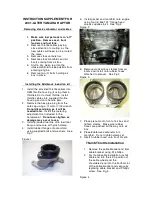
erwise seriously damage the brake sys-
tem which is not covered by the smart
Limited Warranty.
i
The ESP
®
will only function properly if
you use wheels of the recommended tire
size (
Y
page 216).
Hydraulic brake assistant
The hydraulic brake assistant operates in
emergency situations. If you apply the
brakes very quickly, the hydraulic brake
assistant automatically provides full
brake boost, thereby potentially reducing
the braking distance.
X
Apply continuous full braking pressure
until the emergency braking situation is
over.
The ABS will prevent the wheels from
locking.
When you release the brake pedal, the
brakes function again as normal. The
hydraulic brake assistant is then deacti-
vated.
G
WARNING
When the hydraulic brake assistant is mal-
functioning, the brake system is still func-
tioning normally, but without the addi-
tional brake boost that would normally be
provided during an emergency braking
maneuver. Therefore, the braking distance
may increase.
G
WARNING
The hydraulic brake assistant cannot pre-
vent the natural laws of physics from acting
on the vehicle, nor can it increase braking
efficiency beyond that afforded by the con-
dition of the vehicle brakes and tires or the
traction afforded. The hydraulic brake
assistant cannot prevent accidents,
including those resulting from excessive
speed in turns, following another vehicle
too closely, or hydroplaning. Only a safe,
attentive, and skillful driver can prevent
accidents. The capabilities of a hydraulic
brake assistant equipped vehicle must
never be exploited in a reckless or dan-
gerous manner which could jeopardize the
user’s safety or the safety of others.
Activating the hazard warning flasher
after an emergency braking maneuver
If you bring the vehicle to a complete stop
by strongly braking at a speed of more than
43 mph (70 km/h), the hazard warning
flasher comes on automatically as soon as
the vehicle is at a standstill. The hazard
warning flasher will remain on until it is
switched off using the hazard warning
flasher switch (
Y
page 68) or until the
speed of the vehicle has exceeded 6 mph
(10 km/h).
Acoustic Vehicle Indication*
Vehicles with electric motors develop con-
siderably lower driving noises than vehi-
cles with combustion engines. Therefore
your vehicle in traffic might not be acous-
tically noticed by other road users in cer-
tain situations.
In order to avoid this, a built-in sound
generator emits a certain noise (Acoustic
Vehicle Indication) within a speed range
between 0 to 20 mph (30 km/h). Thus, other
road users, especially pedestrians and
bicycle riders can notice your vehicle bet-
ter. Acoustic Vehicle Indication can also
be heard inside of the vehicle.
The volume of Acoustic Vehicle Indication
depends on the current engine speed (rpm).
The stronger you accelerate, the louder the
noise. At speed of more than 20 mph
30 km/h the noise is switched off. From this
speed on the natural noises of the vehicle
are sufficient so that other road users can
notice the vehicle on time.
48
Driving safety systems
>>
Safety.
* optional
Содержание 2014 fortwo
Страница 4: ......
Страница 22: ...20...
Страница 31: ...Safety Occupant safety 30 Panic alarm 45 Driving safety systems 46 Anti theft systems 49...
Страница 209: ...Fuse box Front side Fuse y Backup fuse slots Fuses 207 Practical hints Z...
















































